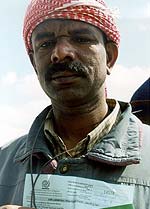| Egypt / the
Middle East

The Middle East for centuries has witnessed large migratory movements, both internally and across borders. Some people moved in search of better living opportunities, while others were forced out by conflicts and civil wars. Palestinians constitute the largest single group to have been displaced in this region.
Like the rest of the Middle East, migration has always been an important part of Egypt’s history. Until the mid-1950s, Egypt was largely a country of immigration. But increasing economic pressures and high rates of population growth converted Egypt into a country of emigration, coinciding with the oil boom in the Arab Gulf countries and the resulting demand for manpower. Internal migration began as a response to poverty and the uneven distribution of economic activities, and acted as a balancing mechanism when Egyptian migration flows to the Gulf and elsewhere began.
With about 2.7 million Egyptians abroad (1.9 million in the Arab Gulf countries alone), coupled with overpopulation and rampant unemployment, Egyptian migration can be seen as a livelihood and survival strategy. In addition to migrating internationally, over 5 million Egyptians move internally to sustain rural livelihoods. These movements, and the remittance flows they have engendered, have undoubtedly had an impact on development. The Migration DRC research looks at the links between internal and international migration in the Egyptian context, as well as at the particular conditions of Egyptian migrants abroad. A further research project profiles female domestic workers from overseas working in Egypt, and examines their conditions of work and their vulnerabilities.
The Arab states and neighbouring countries in the Middle East are also host to a large number of forced migrants. The region is host to the largest refugee population in the world, estimated by the US Committee for Refugees at 5,289,400 million in 2003. Though official figures tend to include only refugees and asylum seekers in this category, there are others subjected to similar forced movements including the internally displaced, and those forced to move for economic or environmental reasons. While the exact number of such migrants cannot be determined, it is likely to be significantly larger than projections made on the basis of strict definitions.
The Arab region has witnessed vast refugee population flows out of Palestine, Iraq, Somalia, Sudan, into Egypt, Lebanon, Jordan and Syria, and these movements clearly impact the societies into which they are flowing. Although there are conventions tying countries to accept refugees and provide them protection, such as to the 1951 Convention relating to the Status of Refugees and the 1969 Organization of African Unity Convention Governing the Specific Aspects of Refugee Problems in Africa, about half the countries in the Arab world are not signatories to these conventions (e.g. Iraq, Jordan, Kuwait, Lebanon, Oman, Qatar, United Arab Emirates, and Libya), thereby accentuating the impact of forced population movements on countries bound by these conventions. Here again, while states might accept refugees, they might still not be able to access any rights.
Coming from a rights perspective, Migration DRC research projects in Egypt, Sudan and Lebanon have sought to assess the impact of forced migration policies and to question the underlying policy assumptions regarding the role forced migrants play in the social and economic fabric of their host societies.
Following a focus on DFID priority countries in 2008-09, CMRS is not currently actively participating in DRC research, but it is still partnering on number of other projects.
|





